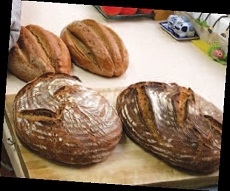Flour, Salt Yeast – and Soul
An article on bread baking in the lifestyle section of The Jerusalem Post caught both my eye and my fancy and so me and myself, enjoying our hard-won pensioner's leisure, decided to try our skills.
The recipe for spelt bread was fairly straightforward: mixing the flour with water and yeast, letting it rise, into a bread pan and then into the oven. First attempts were palatable but then new avenues were opened.
The Internet is a magnificent invention and through it and YouTube, I soon found a kindly gentleman baker ably demonstrating how to improve the quality of the loaf. His video did indeed help and the results were appreciatively savored by my immediate family.
The age-old adage that, "The difference between men and boys is the price of their toys", is indeed well proven and in my case led me to the Amazon site, a veritable Aladdin's Cave of consumer delights. There, I found a wealth of bread making books covering every imaginable variety possible.
Furthermore, you are deluged with a tempting cornucopia of baking accessories that you previously thought never existed. Luckily, our son Asaph travels to the U.S. several times a year on business and he willingly schlepped back my purchases.
Within a few months, I had acquired five impressive tomes to add weight to my bookshelves and broaden my knowledge, plus some assorted gadgets to help improve my techniques.
The more you know, you realize how little you know and this also applies to bread baking. I have been introduced to a host of terms such as: poolish, biga, autolyze, proofing, oven spring, levain and soaker just to name a few.
A world of knowledge has been opened to me and I am on a continuous learning curve.
Concomitant with growing knowledge comes the growing amount of equipment needed to put all this into practice.
I have taken over a shelf in a kitchen cupboard and it – at the present time – contains a Dutch oven, a food and an oven thermometer, bread pans, a pizza stone, a Danish dough whisk, a large home carpentered flour/pizza board, water sprayer, a measuring cup, a digital scale, assorted wooden spoons, spatulas, containers and various odds and ends while two banneton bread proofing baskets from AliExpress, the Chinese purchase site, have made their home there too.
"OK," you ask, "Has all this acquisition borne fruit?" "Has all this paraphernalia, been put to use?" My answer would be in the affirmative. So far, I have baked a passable artisan rye loaf, ciabatta, Sicilian semolina loaf, whole wheat loaves with sunflower and pumpkin seeds, artisan white and brown loaves and a few trays of bagels.
My clientele has expanded beyond my family. I have brought rye loaves to relations and friends and when celebrating my birthday, baked breads to bring to the guys in my Aikido class. The feedback and feeding have been positive, especially with my fellow Aikidoists, who, ravenous after practice, made the loaves and accompanying refreshments vanish in no time at all.
Delving into the world of bread making has revealed the intricacies of the art. Reading the different books written by professional artisan bakers with their backgrounds in professional studies and practice is not only most illuminating, but also intellectually stimulating as you discover the mechanics and chemistry involved in the creation of bread.
Nevertheless, all the authors have one thing in common: a love of their profession, the joy in baking a perfect loaf and the desire to share their knowledge with their readers.
One of the books that I particularly enjoy reading is The Bread Baker's Bible. In the preface, author Rose Levy Beranbaum mentions the tastes and smells of bread that evoke memories of her childhood – how a bagel was used as her teething ring and how her father, returning from a visit to her grandparents, would always bring a fresh rye loaf home.
She recalls passing the neighborhood bakery, looking in the window, seeing the newly stacked loaves and inhaling that delicious fragrance that emanated from them.
Reading her words unleashed many memories locked within me – of food prepared by my mother and members of my family who are long gone. This, to me, is soul food, as intimately linked with the dishes themselves as the love I had for those who prepared it and the warm associations of places and occasions.
My mom's eldest sister, my Aunt Ada lived in Wellington, a small farming town, located 80 km. from Cape Town. Their home, a former farmhouse with high beamed ceilings and a large yard, was off the quiet main road in an even quieter side street.
On the high holidays and on Passover, after our Dad, Solly, had untimely passed away, my mom, my brother Robert and I would come and stay over.
Seated around the festive evening meal table with Aunt Ada, Uncle Michael, just returned from conducting the evening service at the small local shul, and with our Zaida (Yiddish for grandpa) Wolf Harris, we would enjoy my aunt's traditional floemen tsimmis – brisket cooked in rich gravy of carrots and prunes.
It was not just the food, but the sense of occasion. A family meal with three generations participating was an exercise in perpetuating a cultural tradition.
Appropriately dressed, we were seated according to age, waited our turn to be served, politely participating in table talk and in asking for seconds. If necessary to get up, permission was asked to leave the table.
At the risk of being called a dyed in the wool reactionary (with which our children would readily concur!), I still defend this tradition. It instilled within us the culture of politeness, table manners, the virtue of patience and imbued us with respect for our elders. Nowadays, the pendulum has possibly swung a bit too far.
As the ubiquitous cell phone has relentlessly invaded every living space and as we are mercilessly bombarded by the media with the message of the precedence and predominance of youth culture, a little dab of antediluvian antidote can't harm.
Many Sunday afternoons had a certain ritual. Our parents, enjoying a well-earned full day of rest, would go for a Sunday afternoon drive which often culminated in a stop outside the two Jewish delicatessens: Milly's and Barnie's in Buitekant Street, Cape Town.
These establishments had a special atmosphere redolent with the fragrance of the good things on their shelves and on their counters – smoked and pickled fish, cheeses, pickled cucumbers, smoked and pickled meats and baked items. There, the customary bagels, lox and special firm white cheese with chives were bought for our evening supper. Their taste is still with me!
Of course, the pre-Pesach trip to the delicatessens was an event in itself, as the special kosher delicacies of Lithuanian-Jewish tradition especially prepared for that festival were purchased.
The taiglach, imberlach (made from carrots and dried fruits), pletzelach (from plums) and the fizzy mead that would sometimes explode from its bottles are just a few that I remember.
Our mom also had her special dishes from the traditional Jewish cuisine. I have a special place in my heart for chopped liver and especially chopped herring on kichel (a light, crispy sweet biscuit-like delicacy).
I can still picture standing near her while she was preparing the dish and extending a finger for me to taste the herring on it. Then there was p'cha, a dish she made from jellied calves foot that also contained pepper, garlic and hard-boiled eggs. Even though our dad loved it, I could never work up an enthusiasm for that rubbery, jelly-like substance.
Pride of place was taken by cheesecake with raisins. Nobody could make it like our Mom and of the many that have tickled my palate, none could match the lightness of crust and fluffiness of the cheese in her baking. Whenever offered a slice, I feel a tug at my heart.
Baking bread at home – an infinitely satisfying process of creation and giving – has brought the wheel full circle. You carefully measure and weigh the ingredients, mix them together and then patiently wait to see the dough rise.
After the initial rise, the mixture is poured onto the floured counter to be kneaded, if necessary, for the right amount of time and in the correct manner – a skill which is tactilely most gratifying as you feel the dough taking shape. Then you let it rest before the desired shaping after which it proofs for an hour or two or more as needed.
Lastly, into a preheated oven where in the first ten minutes, oven spring (when the bread quickly swells as the carbon dioxide and alcohol generated by the yeast cells plus the water contained by the gluten strands is evaporated by the heat) takes place.
Then, the finished product must be left on a rack to cool as the crumb and crust of the loaf take on their final flavor.
The best part of it all is the pleasure of giving it to our children and grandchildren. Adi, our daughter, has a soft spot for bagels so whenever she comes to fetch them from us, the bag is always minus one or two to take home as the warm product is consumed on the spot.
Our mom, Evelyn's cooking was done with love and that gave it that indefinable special taste. I like to feel that mine carries on that same tradition and I'm sure that she, blessed be her memory, would have approved.










Comments